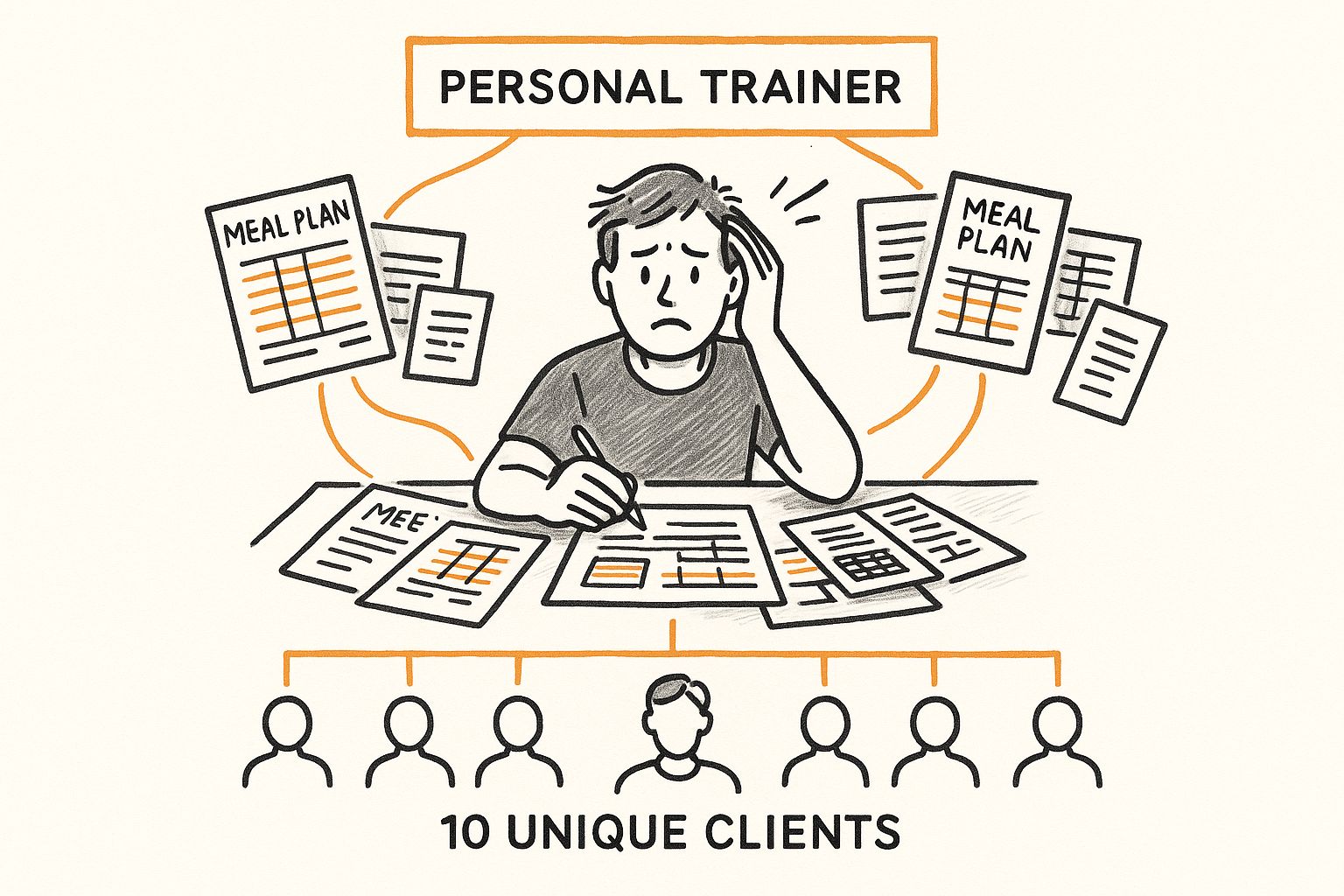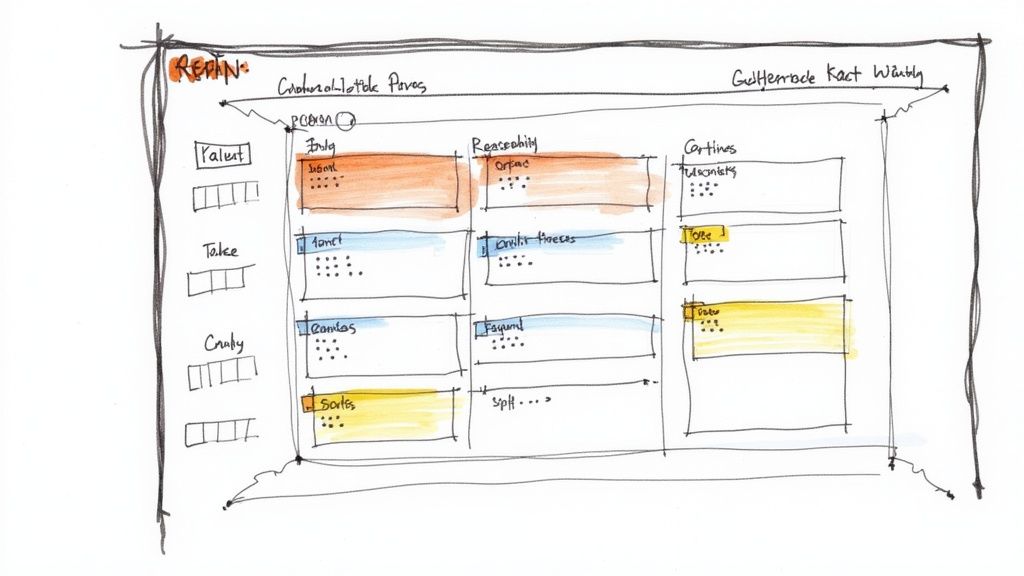Explore the best nutrition software for personal trainers to optimize coaching, improve client outcomes, and grow your fitness business today.
This article is proposed by Gymkee, the personal trainer software that allows you to deliver the best coaching experience to your clients while saving time and growing your personal training business.
Try Gymkee for free for 14 daysManaging nutrition coaching with spreadsheets and scattered PDFs is a recipe for burnout. For personal trainers, the manual approach creates a constant battle: deliver personalized advice or drown in admin. This old-school method doesn't just consume your time; it limits your ability to deliver the data-driven results that retain clients.
Imagine you have ten clients, each with different goals and dietary needs. One is a vegan athlete needing high protein, another has a gluten intolerance, and a third is just starting to build healthier eating habits.
Creating, tracking, and tweaking meal plans for that group by hand is an operational nightmare. You're trapped in a cycle of endless calculations and follow-up emails, losing hours you should be spending on coaching.
This isn't just an inconvenience—it's a massive missed opportunity. When you can't personalize at scale, the quality of your coaching suffers. Clients get generic advice that doesn't adapt to their progress, leading to frustration and a higher chance they'll quit.
This is where nutrition software for personal trainers changes the game. It's not just another tool; it’s a fundamental shift in how you operate. Instead of drowning in spreadsheets, you use a central hub to build and adjust meal plans in minutes. Making this switch is non-negotiable for any trainer serious about growing their business.
This infographic shows the common pain points of a trainer juggling multiple clients manually, illustrating how quickly things get out of control.

The image highlights the friction between client needs and what a trainer can realistically deliver manually, making the case for a smarter system.
The core problem with manual coaching isn't a lack of effort—it's a lack of leverage. Software provides that leverage, allowing you to multiply your impact without multiplying your workload.
This evolution is already happening across the industry. The personal training software market was valued at over USD 2.1 billion in 2025 and is projected to hit USD 3 billion by 2035. The fuel for this growth is a global rise in health consciousness and the demand for digital solutions to manage chronic issues like obesity and diabetes.
You can read the full research about the personal training software market to see the forces driving this change. The takeaway is simple: adopting the right tools is no longer a luxury. It's a necessity for staying competitive.
Choosing the right nutrition software for personal trainers can feel overwhelming. Let's cut through the marketing noise. This is your practical guide—no fluff, just what actually matters for your coaching and your clients' success.

It’s easy to get distracted by flashy features that don't solve real problems. The goal is to focus on the non-negotiable tools that will make your life easier and get your clients better results.
This is the core of any solid nutrition platform. It's about your ability to create and modify meal plans without wasting time. The real value is in scalable personalization.
A great meal planning tool must let you:
This level of detail means you deliver plans clients actually follow because they fit their life. To see how this works, check out a dedicated nutrition builder like the one offered by Gymkee.
Imagine your client tries to log their lunch and finds ten different entries for "grilled chicken breast," all with different nutritional info. An unverified database creates confusion and undermines your coaching.
A verified food database is non-negotiable. It ensures the data is accurate and consistent, giving both you and your clients confidence in the numbers. Look for software that includes barcode scanning to make logging fast, simple, and precise.
A great food database isn't just about size; it's about accuracy. When clients trust the data, they are far more likely to remain consistent with their tracking and their results.
Client progress tracking must be more than a digital logbook. It needs to be a dynamic, motivational tool that shows clients the real impact of their work. Spreadsheets show numbers, but they can't tell a story.
Effective progress tracking must include:
This transforms data from a list of numbers into a source of motivation, keeping clients engaged.
Juggling emails, texts, and social media DMs is a surefire way to miss important messages and burn out. A top-tier nutrition software for personal trainers centralizes all communication.
An integrated messaging system keeps every conversation in context. You can discuss a specific meal within their food log or give feedback on a workout in their activity feed. This centralized approach prevents things from getting lost and lets you manage client conversations efficiently as your roster grows.
To help you evaluate your options, here’s a quick-reference table outlining the critical features.
Use this checklist when evaluating platforms. If a tool is missing one of these core pillars, it's likely to create more work for you, not less.
Bringing new tech into your business can feel like a major task. But weaving nutrition software for personal trainers into your day-to-day doesn't have to be painful. The key is a rollout that makes life easier for both you and your clients.
Think of it less like adding a task and more like upgrading the operating system of your coaching business. The goal is to make the software an invisible, indispensable part of how you coach. It should handle the tedious work—data entry, follow-ups, spreadsheets—so you can focus on what your clients pay for: your expertise and motivation.
A client's first interaction with your software sets the tone. If it’s confusing or clunky, they won’t use it. A bad onboarding experience is the number one reason clients abandon new tools.
Make this first step seamless.
To nail the transition, keep instructions clear:
The real power of good nutrition software is the ability to create and reuse your best material. Instead of building every meal plan from scratch, you build a library of proven templates that you can tweak for a new client in minutes.
This is the definition of working on your business, not just in it.
Get started by creating a few core templates based on common client goals:
Once these are in your library, you can duplicate and customize them. Client with a dairy intolerance? Swap it out. Someone who dislikes chicken? Change the protein source. This templated approach lets you deliver personalized plans at scale without reinventing the wheel. It’s the backbone of truly simplified client tracking.
The best trainers don't just use software to track numbers; they use it to systemize their expertise. Your template library is your coaching philosophy, made repeatable and scalable.
Integrating software helps you manage and automate customer engagement. This lets you connect with clients more consistently, building stronger relationships that last. Proactive communication makes clients feel supported, which is key for retention and results.

Let's connect features to revenue. The right nutrition software for personal trainers has a direct, measurable impact on your bottom line. It’s about turning saved time into tangible business growth.
This is the shift from trading time for money to building a scalable business. Personalization and progress tracking aren't just extras; they're your best tools for keeping clients longer and earning more.
When clients see clear, visual proof that your coaching works, they stick around. Vague promises can't compete with a graph showing their weight trending down or a photo gallery of their transformation. This data-driven approach proves your value month after month.
Software makes this happen by turning abstract goals into concrete achievements. Instead of just telling a client they're doing well, you can show them. That visual feedback is incredibly motivating and builds trust.
Better results lead to better retention. When software helps you deliver a more personalized and responsive coaching experience, clients feel supported and are far less likely to leave.
The personal training industry is growing fast. As of 2024, there are roughly 728,000 personal training businesses globally, a market that has grown 4.8% annually since 2016. To stand out, delivering a superior, tech-enabled service is no longer an option. Discover more insights about the personal training industry's growth and see why differentiation is critical.
Manual coaching limits you to a handful of high-touch clients. Software shatters that ceiling by automating admin work, freeing you up to expand your offerings.
This opens the door to new income sources that were previously too time-consuming.
Consider adding scalable offers like these:
The biggest financial win comes from efficiency. If software saves you five hours of admin work per week, that’s five extra hours for activities that generate revenue.
You could use that time to:
This is what turns your practice into a professional, scalable business. The right nutrition software for personal trainers isn't an expense; it's an investment in your ability to earn more while delivering better results.
Picking the right nutrition software isn't a one-size-fits-all decision. The market is crowded, and the wrong choice can cost you time, money, and clients.
The key is to find a tool that matches your coaching style, your clients' needs, and your business goals. Let's break down the main options.
Most software falls into one of three categories. Understanding the difference is the first step to making a sound decision.
The demand for these tools is exploding. The fitness app market is projected to grow from USD 10.59 billion in 2024 to USD 33.58 billion by 2033. This shows that clients are already looking for digital health solutions. You can discover more insights about the fitness app market's growth to see how significant this trend is.
Which one is for you? It depends on how you run your business. A solo trainer has different needs than a gym owner managing a team. To get a feel for the landscape, explore software marketplaces like Capterra and read user reviews.
The best software for you is the one that disappears into your workflow. It should amplify your coaching, not complicate it.
To help you decide, let's look at the pros and cons of each type. Our guide on the best online personal training platforms also gives a wider view of the tools available.
This breakdown shows how the three main types of nutrition platforms stack up, helping you align a tool with your specific coaching needs.
This table shows a clear trade-off between specialization and convenience. Your choice hinges on whether you prioritize deep nutritional features or a seamless, all-in-one client experience.
For most personal trainers who coach both fitness and nutrition, an all-in-one platform like Gymkee is the logical choice. It saves you from juggling multiple apps and gives your clients a seamless, professional experience under your brand.
If your business is built only on nutrition coaching, a dedicated platform is likely the smarter move. But if you ever decide to add workout programming, you'll have to figure out how to integrate two different systems.
Your software choice should support where your business is today and where you want it to go tomorrow. Don't pick a tool that solves a small problem now but creates a bottleneck later.
Stepping into the world of nutrition software is a big move. It’s normal to have questions. This decision impacts how you work, how your clients feel, and your bottom line.
Here are straight answers to the most common questions from trainers.
This is the most critical question you should ask.
When a client shares sensitive health data—weight, medical history, eating habits—they are placing enormous trust in you. Protecting this information is an ethical and often legal responsibility.
Reputable nutrition software platforms invest heavily in data security. They use encryption to protect data both in transit and at rest. Before you commit, look for a clear privacy policy. Ensure the platform is compliant with data protection laws in your region, like GDPR in Europe or HIPAA in the United States if you handle medical info. A trustworthy company will be transparent about its security measures.
A tool is only as good as its adoption rate. The fanciest features are useless if the app is clunky or confusing.
Client adoption comes down to one thing: user experience.
Look for a platform with a clean, intuitive client-facing app. Here’s what matters:
Your clients are busy. The easier you make it for them to track their progress and communicate with you, the more consistent they will be. A great user experience directly translates to better client results.
The best way to know for sure? Sign up for a free trial and use the app from a client's perspective. If you find it frustrating, so will they.
The "real" cost is more than the monthly subscription fee. You must also factor in the time and effort it takes to get everything running.
First, look at the pricing model. Most platforms offer tiered plans based on your number of active clients, which allows you to start small and scale your investment. Be wary of software that demands a large upfront payment or locks you into a long-term contract without a trial.
Next, consider the time investment. How long will it take to learn the software and onboard your clients? A platform with a steep learning curve can cost you hours in lost productivity. Look for one with a straightforward setup, good tutorials, and responsive customer support.
Finally, check for hidden costs. Does the platform charge extra for a branded app, payment processing, or "premium" features? A good company has transparent pricing. The goal is to find a solution that gives you a clear return on investment by saving you time and helping you retain clients.
This is an important distinction. Nutrition software for personal trainers is a tool to help you guide and track clients' habits within your scope of practice. It automates calculations, simplifies meal planning, and streamlines communication.
It is not a substitute for the clinical expertise of a Registered Dietitian (RD).
RDs are qualified to diagnose and treat medical conditions through nutrition therapy, such as managing diabetes, kidney disease, or eating disorders.
Your role as a trainer is to provide general nutrition guidance to healthy individuals. The software is your assistant in that process. Always be clear about your qualifications and refer clients to a medical professional when their needs fall outside your expertise. The software helps you do your job better; it doesn't change what your job is.
Ready to stop juggling spreadsheets and start delivering a world-class coaching experience? Gymkee combines powerful nutrition tools with seamless workout programming in one easy-to-use platform. Save time, get better client results, and grow your business. Start your free 14-day trial today.
This article is proposed by Gymkee, the personal trainer software that allows you to deliver the best coaching experience to your clients while saving time and growing your personal training business.
Try Gymkee free for 14 days